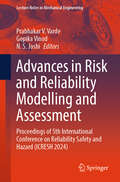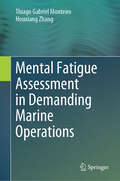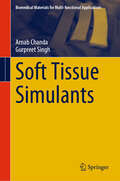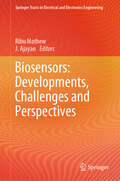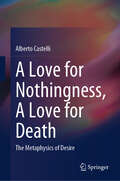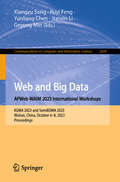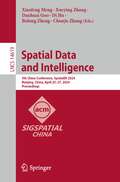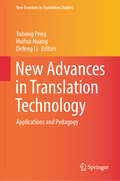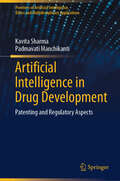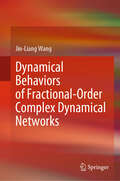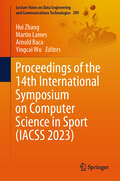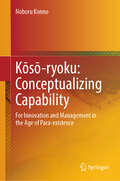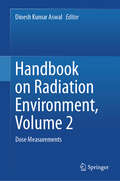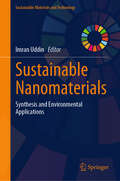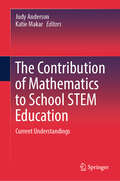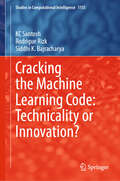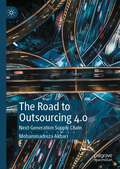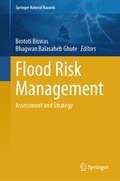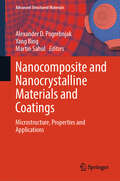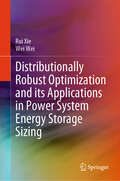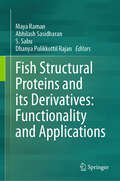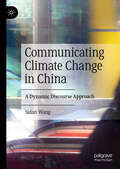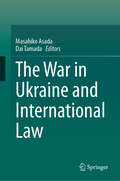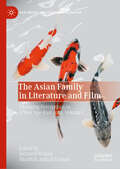- Table View
- List View
Advances in Risk and Reliability Modelling and Assessment: Proceedings of 5th International Conference on Reliability Safety and Hazard (ICRESH 2024) (Lecture Notes in Mechanical Engineering)
by Prabhakar V. Varde Gopika Vinod N. S. JoshiThis book presents the proceedings of the 5th International Conference on Reliability Safety & Hazard-2024, held in Mumbai during February 21–24, 2024. It covers the latest advances in artificial intelligence and machine learning in development of risk-conscious culture. Various topics covered in this volume are reliability prediction, precursor event analysis, fuzzy reliability, structural reliability, passive system reliability, digital system reliability, risk-informed approach to decision making, dynamic PSA, uncertainty and sensitivity modeling, among others. The book is a valuable resource for researchers and professionals working in both academia and industry in the areas of complex systems, safety-critical systems, and risk-based engineering.
Mental Fatigue Assessment in Demanding Marine Operations
by Houxiang Zhang Thiago Gabriel MonteiroThis book investigates how human mental fatigue (MF) can be objectively measured during demanding maritime operations. The maritime domain is characterized by demanding operations. These operations can be especially complex and dangerous when they require coordination between different maritime vessels and several maritime operators. The best approach to quantify MF is through the use of physiological sensors including electroencephalogram (EEG), electrocardiogram, electromyogram, temperature sensor, and eye tracker can be applied, individually or in conjunction, in order to collect relevant data that can be mapped to an MF scale. More than simpler sensor fusion, this book bridges the gap between relevant sensor data and a quantifiable MF level using both data-driven and model-based approaches. Data-driven part investigates the use of different NNs combined for the MF assessment (MFA) task. Among the different architectures tested, convolutional neural networks (CNN) showed the best performance when dealing with multiple physiological data channels. Optimization was used to improve the performance of CNN in the cross-subject MFA task. Testing different combinations of physiological sensors indicated a setup consisting of EEG sensor only was the best option, due to the trade-off between assessment precision and sensor framework complexity. These two factors are of great importance when considering an MFA system that could be implemented in real-life scenarios. The model-based discussion applies the current knowledge about the use of EEG data to characterize MF to develop an MF approach to quantify the progression of MF in maritime operators. In the research presented in this book, realistic vessel simulators were used as a platform for experimenting with different operational scenarios and sensor setups.
Soft Tissue Simulants (Biomedical Materials for Multi-functional Applications)
by Gurpreet Singh Arnab ChandaSoft tissue simulants, essential for automotive and ballistic testing, medical, and surgical training, have traditionally relied on cadavers and animal tissues. However, their biomechanical properties change with time due to dehydration after death and the biomechanics of the animal models cannot be translated and compared with the human tissues. This book compiles various synthetic tissues used in these applications, addressing their characterization and industry-wide applications. While older simulants lack biofidelity, recent advancements in biofidelic soft tissue simulants offer promising alternatives, yet technology transfer remains limited. This book fills the gap by exploring each simulant's characteristics and current trends, facilitating their adoption in clinical and academic settings. These synthetic tissues have the potential to replace live tissues in surgical training, streamlining biosafety approvals. They also benefit academic researchers by reducing costs and time in biomechanical testing. Anticipated to be the first of its kind, this comprehensive reference book will showcase recent advancements in soft tissue simulant development, serving as a cornerstone text in tissue engineering & biomedical engineering, medical simulation, biomechanics, and related fields.
Biosensors: Developments, Challenges and Perspectives (Springer Tracts in Electrical and Electronics Engineering)
by J. Ajayan Ribu MathewThis book equips its readers with fundamental concepts and a comprehensive understanding of the principle and functionality of biosensors. This book focuses on various biosensor technologies like field effect transistor (FET), plasmonics, bioresorbable biosensors, electro-chemical biosensors, etc., and their applications. The book also covers the reliability aspects and challenges in biosensor development that are a major cause of erroneous calibration and even failure. The book also features the concept of bio receptors, immobilization techniques, target-receptor interactions, surface energy changes, sensitivity, selectivity, etc. This would be an ideal reference for researchers and scholars studying biosensors realized with various material sets and technologies including state-of-the-art modern materials and innovative techniques.
A Love for Nothingness, A Love for Death: The Metaphysics of Desire
by Alberto CastelliThis book aims at explaining romantic love between straight adults through literary texts of the western canon from the nineteenth and twentieth century. Each chapter comes with a multidisciplinary approach in which protagonists are mutilated in their quest for loving as alternative to annihilation. The book emphasizes love as an obsession, thus as an exploration of the mind. From the passion-myth of Tristan and Isolde to the nihilist modernist representations, the western world has created a perverse concept of love. A love for nothingness, for death. Narcissistic and at times destructive, love is gained by overcoming obstacles. If without obstacles there is no love, then love becomes love for obstacles. Within this masochistic frame, love, falling in love, being loved always stand at the edge of pathology. At its core this book narrates a love story, more precisely a story of loves, the haunting evocation of a desire that by its very nature cannot be fulfilled. Inherent in the nature of love is a subtle dialectical activity between presence and absence, between creation and destruction, reality and void. Accordingly, the narrative raises questions that the past two centuries were incapable of answering. Does love only last the time of a kiss? Is its promise fatally destined to dissolve? What about violence? Physical, emotional, temporal. Is it an ineliminable part of love or its most extreme profanation? And what is the mystery that accompanies loves that know how to last without resigning themselves to the death of desire? It is to answer some of these questions that I wrote this text. Love is an unconscious process that dominates reason and destroys it when reason cannot be a mode of communication. Hence, the amorous romance is madness and this text is written as a loud reminder.
Web and Big Data. APWeb-WAIM 2023 International Workshops: KGMA 2023 and SemiBDMA 2023, Wuhan, China, October 6–8, 2023, Proceedings (Communications in Computer and Information Science #2094)
by Jianxin Li Geyong Min Xiangyu Song Ruyi Feng Yunliang ChenThis proceedings constitutes selected papers from the Workshops KGMA and SemiBDMA which were held in conjunction with APWeb-WAIM 2023 which took place in Wuhan, China, during October 6-8, 2023. The 7 full papers included in this book were carefully reviewed and selected from 15 papers submitted to these workshops. They focus on new research approaches on the theory, design, and implementation of data management systems.
Spatial Data and Intelligence: 5th China Conference, SpatialDI 2024, Nanjing, China, April 25–27, 2024, Proceedings (Lecture Notes in Computer Science #14619)
by Xiaofeng Meng Xueying Zhang Bolong Zheng Danhuai Guo Di Hu Chunju ZhangThis book constitutes the refereed post proceedings of the 5th China Conference on Spatial Data and Intelligence, SpatialDI 2024, held in Nanjing, China, during April 25–27, 2024. The 25 full papers included in this book were carefully reviewed and selected from 95 submissions. They were organized in topical sections as follows: Spatiotemporal Data Analysis, Spatiotemporal Data Mining, Spatiotemporal Data Prediction, Remote Sensing Data Classification and Applications of Spatiotemporal Data Mining.
New Advances in Translation Technology: Applications and Pedagogy (New Frontiers in Translation Studies)
by Defeng Li Yuhong Peng Huihui HuangFrom using machine learning to shave seconds off translations, to using natural language processing for accurate real-time translation services, this book covers all the aspects. The world of translation technology is ever-evolving, making the task of staying up to date with the most advanced methods a daunting yet rewarding undertaking. That is why we have edited this book—to provide readers with an up-to-date guide to the new advances in translation technology. In this book, readers can expect to find a comprehensive overview of all the latest developments in the field of translation technology. Not only that, the authors dive into the exciting possibilities of artificial intelligence in translation, exploring its potential to revolutionize the way languages are translated and understood. The authors also explore aspects of the teaching of translation technology. Teaching translation technology to students is essential in ensuring the future of this field. With advances in technology such as machine learning, natural language processing, and artificial intelligence, it is important to equip students with the skills to keep up with the latest developments in the field. This book is the definitive guide to translation technology and all of its associated potential. With chapters written by leading translation technology experts and thought leaders, this book is an essential point of reference for anyone looking to understand the breathtaking potential of translation technology.
Artificial Intelligence in Drug Development: Patenting and Regulatory Aspects (Frontiers of Artificial Intelligence, Ethics and Multidisciplinary Applications)
by Kavita Sharma Padmavati ManchikantiThis book discusses how Artificial Intelligence developments have revolutionized the area of medicine and how companies use them to develop applications. While the book covers the growth of AI in medicine and the early developments in AI based medical tools, it provides an in-depth analysis of the current developments in relation to the area of medical diagnostics. The book focuses on how enterprises and institutes have developed their intellectual property portfolio, particularly patents, in this area. Cross-country patenting analysis helps in understanding key areas of growth in certain markets and also company strategies and arrangements. The introduction of AI based products in market is subject to regulation. The developments in policy and regulation influence the development and deployment of such products into the market. This book brings focus to the development of policy and regulation and how regulatory developments impact the introduction of AI-based healthcare products from a cross-country perspective. Further, how regulatory developments lead to the evolution of standards, build reliability and safety in this area are also examined. The unique aspect of this book is the comprehensive coverage of the dual aspects of the nature and scope of AI-based innovations in health care and the related drug regulatory aspects which are imperative for the understanding for students, researchers, and those who work in this area.
Dynamical Behaviors of Fractional-Order Complex Dynamical Networks
by Jin-Liang WangThis book benefits researchers, engineers, and graduate students in the field of fractional-order complex dynamical networks. Recently, the dynamical behaviors (e.g., passivity, finite-time passivity, synchronization, and finite-time synchronization, etc.) for fractional-order complex networks (FOCNs) have attracted considerable research attention in a wide range of fields, and a variety of valuable results have been reported. In particular, passivity has been extensively used to address the synchronization of FOCNs.
Proceedings of the 14th International Symposium on Computer Science in Sport (Lecture Notes on Data Engineering and Communications Technologies #209)
by Hui Zhang Martin Lames Arnold Baca Yingcai WuThis book is a compilation of selected papers from the 14th International Symposium on Computer Science in Sport (IACSS 2023), held on September 27-30, 2023 in Hangzhou, China. The work focuses on the application of computer science and technology in the field of sports (such as intelligent data collection, data mining, visual analysis of game data, virtual reality, machine learning, computer vision, match prediction models and performance analysis). The contents make valuable contributions to academic researchers, college students, coaches and athletes, and sports management personnel (such as managers of sports associations, training bases, and professional clubs). Additionally, readers will encounter new ideas for realizing a more efficient and convenient training and exercise system.
Kōsō-ryoku: For Innovation and Management in the Age of Para-existence
by Noboru KonnoThis book examines conceptualizing capability (kōsō-ryoku), the most important ability for thriving in the era of innovation. A new approach, "formative conceptualizing capability," is proposed as the core knowledge methodology for innovation and management, which is is a fundamental human ability that goes beyond the boundaries between cognitive and tangible realities to shape concepts and drive innovation. Traditional studies on imagination in Western philosophy are combined with knowledge creation theory based on Eastern way of thinking. The book argues the capability should be at the core of innovation management, offering insights and principles for navigating the challenges of the present age. Japan has experienced the world's earliest capitalist setback and is stuck in a prolonged stagnation. The author maintains, however, that what is needed in this coming chaotic era is not only “imagination”, as it would be called in English, but also the power of creating kōsō, the Japanese term for “formative concept”. The author has a proven track record in research and practice on knowledge creation theory, innovation management, design thinking, and scenario planning. He has reorganized and set forth in this book the perspectives he has proposed under the theme of kōsō-ryoku to present a new methodology of knowledge for living in the twenty-first century.
Handbook on Radiation Environment, Volume 2: Dose Measurements
by Dinesh Kumar AswalThe handbook aims to provide a comprehensive resource for understanding ionizing radiation dosimetry, catering to experts, policymakers, and interested readers. The content of the handbook is focused on two main aspects of dose measurements: external dosimetry and internal dosimetry. The section on external dosimetry covers fundamental principles and discusses monitoring techniques across various environments, such as nuclear, industrial, research, and medical facilities. It also covers advanced topics like Bayesian inference and retrospective dosimetry. The internal dosimetry section explores radionuclide biokinetics, simulation techniques, dose evaluation, and monitoring methods. Specific scenarios, such as radon inhalation and off-normal conditions, are addressed, highlighting the importance of precision and intervention. The handbook serves as a comprehensive resource for students, academicians, scientists, engineers, and policymakers interested in seeking an in-depth knowledge of radiation dose measurements and its multi-faceted aspects in protecting human health and the environment.
Sustainable Nanomaterials: Synthesis and Environmental Applications (Sustainable Materials and Technology)
by Imran UddinThis book brings together various topics of nanomaterials in various industrial applications to promote sustainable development practices. The first part of the book describes green nanotechnology for clean energy and environmental sustainability, which includes heavy metal detoxification from water, wastewater remediation, dye degradation, and bioremediation. The second part of the book covers sustainable biomedical applications of nanomaterials such as antibacterial activity and drug delivery systems, which includes the toxicological as well as the antibacterial impacts that nanoparticles have on microorganisms. The subsequent chapters discuss the roles of nanomaterials for sustainability in agriculture, crop protection, plant disease management, food technology (increasing the efficiency of the food industry), and the textile industry. The book caters to researchers and scientists who are interested in the utilization of nanomaterials to enhance sustainable industrial practices.
The Contribution of Mathematics to School STEM Education: Current Understandings
by Katie Makar Judy AndersonThis book presents contemporary STEM education research conducted by mathematics education researchers and their collaborators which highlights the important and pivotal role of mathematics in school STEM education. It showcases evidence of the types of integrated curriculum approaches to STEM education which highlight mathematics as a key component and where mathematical concepts can be learnt through integrated tasks. These examples challenge the idea that mathematics is just an application or ‘servant’ to the other STEM subjects and highlight the contribution that mathematics can make to the understanding and practices of the other STEM subjects. This book fills a void in the current research literature on the role of mathematics in STEM education, provides evidence of the possibilities for designing integrated STEM curriculum and highlights current understandings of the role of mathematics in school STEM education. For researchers, it identifies and elaborates gaps to encourage further exploration in this field.
Australia in AUKUS: Rise of a Leviathan State
by Erik PaulThis book focuses on the making and implication of AUKUS for Australians in their relations with their own state and governance, the Asia-Pacific region and the rest of the world. AUKUS is an incipient military state and a highly dangerous development, moving rapidly to integrate society, the state and the economy in the US imperial project of warfare and global domination. It constitutes the crucible of a Leviathan state, militarising climate change. The study in this book is framed in a geopolitical analytical paradigm of revolutionary and counterrevolutionary movement and power energising together the existential threat of climate change to humans and capitalism, questioning the viability of the nation-state system, highlighting the predicament confronting Australians as a nation. The book’s analysis is presented in four chapters, broadly indicated in the contents page. The book’s architecture is framed in the political philosophy and intellectual legacy of Eric Hobsbawm, Rosa Luxemburg and George Orwell and their contribution to the understanding of the contradictions of the nation-state and imperialism, capitalism and socialism, in the emancipation of humanity from war.
Cracking the Machine Learning Code: Technicality or Innovation? (Studies in Computational Intelligence #1155)
by KC Santosh Rodrigue Rizk Siddhi K. BajracharyaEmploying off-the-shelf machine learning models is not an innovation. The journey through technicalities and innovation in the machine learning field is ongoing, and we hope this book serves as a compass, guiding the readers through the evolving landscape of artificial intelligence. It typically includes model selection, parameter tuning and optimization, use of pre-trained models and transfer learning, right use of limited data, model interpretability and explainability, feature engineering and autoML robustness and security, and computational cost – efficiency and scalability. Innovation in building machine learning models involves a continuous cycle of exploration, experimentation, and improvement, with a focus on pushing the boundaries of what is achievable while considering ethical implications and real-world applicability. The book is aimed at providing a clear guidance that one should not be limited to building pre-trained models to solve problems using the off-the-self basic building blocks. With primarily three different data types: numerical, textual, and image data, we offer practical applications such as predictive analysis for finance and housing, text mining from media/news, and abnormality screening for medical imaging informatics. To facilitate comprehension and reproducibility, authors offer GitHub source code encompassing fundamental components and advanced machine learning tools.
The Road to Outsourcing 4.0: Next-Generation Supply Chain
by Mohammadreza AkbariThis book provides valuable insights and guidance for firms looking to improve their operations in the face of disruption and uncertainty. It contributes to the body of knowledge in logistics and supply chain disciplines which will be useful to both industry practitioners and academics. With this, the book first emphasizes the road to outsourcing 4.0 by providing updated information and perspectives on these trends, given that outsourcing has evolved significantly over the years and new technologies, such as artificial intelligence (AI), cloud computing, Internet of Things (IoT), and machine learning are changing the way outsourcing is done. In addition, the book also explores new models such as third-party logistics (3PL) providers and crowdsourcing which have changed the landscape of outsourcing. Lastly, the book includes updated best practices for outsourcing, including how to choose outsourcing partners, manage outsourcing relationships, and minimize risks in the post-COVID-19 recovery period. Each chapter in the book goes through concepts, development histories, benefits, risks and challenges, and includes recent case studies
Flood Risk Management: Assessment and Strategy (Springer Natural Hazards)
by Brototi Biswas Bhagwan Balasaheb GhuteThis book examines the nature of flood in different landscapes and the various factors that contribute to flooding in different areas. It identifies flood risk zones in different terrain types and provides valuable insights into the anthropogenic, geographical, hydro-geological, and geomorphological aspects of flood-prone areas to achieve sustainable risk management. The book also explores the impact of avalanches, global warming, and flash floods in different settings where such types of flooding have become more common. In addition, the volume provides case studies to evaluate the impact of flooding in both natural and man-made environments. To better understand and manage floods, the book combines advanced geospatial tools and techniques with indigenous knowledge. Using machine learning and multiple-criteria decision analysis, the book provides an amalgamation of technology and indigenous knowledge to assess flood susceptibility. The book also includes strategies to manage flood risks and case studies that demonstrate best practices in flood risk management. The volume is a valuable resource for researchers, students, and policy makers to understand the causes of floods and their socio-economic impact in different areas.
Nanocomposite and Nanocrystalline Materials and Coatings: Microstructure, Properties and Applications (Advanced Structured Materials #214)
by Alexander D. Pogrebnjak Yang Bing Martin SahulThis book is a collection of reports (reviewed) selected from several sections of the IEEE Nanomaterials: Application and Properties-2023 conference. The book is devoted to the study of films, coatings, and materials obtained by various methods of preparation and deposition, for example, magnetron sputtering of targets, vacuum arc deposition , electron-plasma processing, sintering of composites, plasma jet deposition, and other methods for obtaining nanomaterials. The chapters and reports describe superhard coatings, spark, and plasma alloying of materials (metals, semiconductors, polymers, ceramics).
Distributionally Robust Optimization and its Applications in Power System Energy Storage Sizing
by Wei Wei Rui XieThis book introduces the mathematical foundations of distributionally robust optimization (DRO) for decision-making problems with ambiguous uncertainties and applies them to tackle the critical challenge of energy storage sizing in renewable-integrated power systems, providing readers with an efficient and reliable approach to analyze and design real-world energy systems with uncertainties. Covering a diverse range of topics, this book starts by exploring the necessity for energy storage in evolving power systems and examining the benefits of employing distributionally robust optimization. Subsequently, the cutting-edge mathematical theory of distributionally robust optimization is presented, including both the general theory and moment-based, KL-divergence, and Wasserstein-metric distributionally robust optimization theories. The techniques are then applied to various practical energy storage sizing scenarios, such as stand-alone microgrids, large-scale renewable power plants, bulk power grids, and multi-carrier energy networks. This book offers clear explanations and accessible guidance to bridge the gap between advanced optimization methods and industrial applications. Its interdisciplinary scope makes the book appealing to researchers, graduate students, and industry professionals working in electrical engineering and operations research, catering to both beginners and experts.
Fish Structural Proteins and its Derivatives: Functionality and Applications
by Maya Raman Dhanya Pulikkottil Rajan Abhilash Sasidharan S. SabuThis book brings out a comprehensive collection of information on the structural proteins of fish in both marine and fresh water system. The main focus of this book is to address all relevant aspects of structural proteins of fish and its commercial significance. Fish is a rich and cheap source of protein, and the collagen and myofibrillar proteins, play a key role in food and pharmaceutical industries. Marine-based collagen due to its unique properties have fewer risks of transmitting diseases. These have low molecular weight, are biocompatible, lack religious constraints, and involves cost-effective extraction process. Therefore, it finds wide biomedical applications. The details of its extraction, isolation and characterization, supported with photographs and flow-charts are provided. This book also discusses the different peptides and derivatives of proteins that may have beneficial health significance and other commercial importance. Further, the application of bioinformatics and artificial intelligence in understanding the protein structure in-silico are also discussed in detail. This book is of interest and useful to students, academician, researchers and industrialists/ entrepreneurs, and is a valuable source of reference to the relevant researchers/ students.
Communicating Climate Change in China: A Dynamic Discourse Approach
by Sidan WangThis book explores how China's media narrate climate policy and climate change. With the rapid growth of economy and carbon emissions, China has been seen as having a key role in addressingclimate change and receives substantial attention from the media. In theChinese coverage, climate change issues can be interpreted as various concernsand ideas involving the dimensions of the economy, energy and emissions, publicinvolvement, science and ecology, and responsibility. In this sense, a discourseapproach can be used to understand how the newspapers construct the climatechange discourse and discourse networks in the coverage. This study selectsthree different newspapers in China, namely People’sDaily, China Daily and Southern Weekend. This book will interest scholars of Chinese politics, environmentalists, and media studies scholars.
The War in Ukraine and International Law
by Dai Tamada Masahiko AsadaThe war in Ukraine is fast approaching its second anniversary since its commencement on 24 February 2022 as a blatant aggression by Russia. As we discuss in detail in this book, there are multiple international legal issues that arise and require addressing. What is more, the very international legal order is under threat, insofar as the fundamental international law obligations are not being complied with and the basic international rules are utterly ignored. This book discusses a number of international law issues arising from the war in Ukraine. It covers not only the traditional subjects of war, such as jus ad bellum, international criminal law, and the law of neutrality, but also the relatively new issues arising from the economic sanctions against Russia, including aspects of the WTO law and international investment law. This book provides the readers with opportunities to reconsider the various legal aspects of the war in Ukraine.
The Asian Family in Literature and Film: Changing Perceptions in a New Age-East Asia, Volume I (Asia-Pacific and Literature in English)
by Bernard Wilson Sharifah Aishah OsmanThis book offers a key analysis of the changing perceptions of family in East Asian societies and the dynamic metamorphosis of “traditional” family units through the twentieth century and into the new millennium. The book focuses on investigations of the Asian family as it is represented in literature, film, and other visual media emerging from within China, Japan, South Korea, and Taiwan, and on contestations of the power hegemonies and moral codes that underpin such representations, while also assessing Western and global influences on the Asian family. Individually and collectively, these essays examine traditions and transformations in the evolving conception of family itself and bring together a range of scholars from within and beyond the region to reflect upon the social and cultural mores represented in these texts, the issues that concern Asian families, and projections for future families in their own societies and in a globalized world. Through the written text and the lens of the camera, what directions has the understanding of family in an Asian context taken in the twenty-first century? How have the multiple platforms of media represented, encouraged, or resisted transitions during this time? Amid broader and mutating referential frameworks and cross-cultural influences, is the traditional concept of the “nuclear family” still relevant in the twenty-first century? This book lends further prominence to the diverse literary and cinematic production within East Asia and the eclectic range of media used to represent these ideas. It will be essential reading for scholars of literature, film studies, and Asian studies, and for those with an interest in the cultural and sociological implications of the changing definitions and parameters of the family unit.
